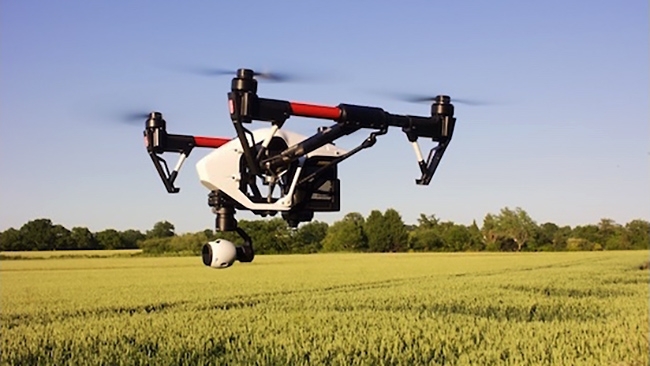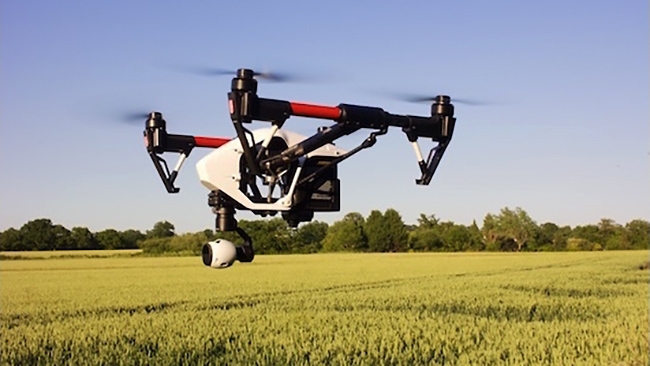
 Simon's own Inspire 1 out above the fields
Simon's own Inspire 1 out above the fields
Learning to fly. As we’ve written before, you can’t just buy a new drone and take to the skies with your new aerial photography business without jumping through some quite serious legal hoops. Simon Wyndham details his experience of the UK system.
The clamour to obtain a Permission For Aerial Work from the UK authority in charge, the CAA, to be able to fly a UAS (Unmanned Aircraft System) commercially has been huge. A quick look at the CAA’s list of approved operators shows just how fast things are picking up.
Thee list of useful applications for UAS operations is a long one and goes way beyond simply obtaining pretty shots for video production too. So, for this reason myself and a colleague decided to embark on our own journey to obtain a Permission For Aerial Work.
We have not yet taken our Operations Test, something I will follow up on in part 2. However I hope that my experiences will be of use to those who are also thinking of taking up Aerial work as part of their services, or even as an entirely new venture.
Choosing a course
There are a number of different course providers who are approved by the CAA to offer ground and flight examinations. They are all slightly different in how they sell their service, but the aim is the same, to establish that you are a safe in operations in order to recommend you to obtain a Permission For Aerial Work (PFAW) from the CAA.
This latter point is important because these organisations do not issue you with a PFAW themselves. Their purpose is to establish in an approved manner that you have the relevant skills to be deemed safe. It is this that the CAA will consider when they are in the process of issuing you with a PFAW.
Various companies, all operating slightly differently, will provided the training you need.There are other routes you can take, too. For instance if you already hold a manned aviation license and you have passed the Model Flying Association certificates the CAA have said that these would count towards being able to be issued with a PFAW as well.
I went with EuroUSC which offers the BNUC-S™ qualification and when you embark on their Ground School course you are issued with two books. One, a rather thick one, regarding European aviation, and the other a UK national supplement for UK specific regulations. While not exactly riveting reading you will need to take it all in since your Ground Exam will be based on the information given.
The two day £840 (inc VAT) course itself consisted of turning up to a hotel in Bristol (other locations Europe-wide are available), where the tuition would be based in a conference room. Much of the information that is given over the two days is based upon the two supplied books, although you can now ask questions to the tutor. There were around 15 people on the course that I attended from many different backgrounds. Some were hobbyists wishing to make some money on the side, while others were video producers and camera operators who wanted to expand their repertoire of skills.
The tuition itself can be rather dry, but there is a heck of a lot of information to take in. From air pressure, to dealing with Air Traffic Control, different airspace types, distance regulations, reading aviation maps, temperature differentials, battery voltages and charging safety amongst a lot more besides.
Because of this it can be a bit daunting to take on, but once you have your qualification you have it for life in the eyes of the CAA, no matter what your individual training company might say (or try to upsell you at a later date).
Exam time
In the afternoon of the second day of the course you will be faced with the Ground Exam. In the case of EuroUSC this is an open book multi-choice paper, which at first might seem like a doddle, but can contain some interestingly ‘trick’ questions.
If I could only give one piece of advice it would be to make sure you can read aviation maps and do latitude and longitude coordinates in your sleep!
I finished my paper well ahead of time and, feeling rather pleased with myself, proceeded to check, double check, and even triple check my answers. I was satisfied, but alas, when the result did come through, it was only 84%. 85% is a pass — I had missed it by one question!
A resit cost £210 (other course providers will allow a free resit, so this is something to consider when choosing who to go with)
This was getting expensive. Not only was a colleague of mine reliant on my passing since we intended to operate as a team, but I have a lot invested in gear, which is counter to all business sense I have. The trouble is that on your flight test your ops manual needs to be tailored to your specific aircraft, and you must be totally familiar with its operation. You simply cannot achieve both these aspects without owning your own equipment. You could try, but I wouldn’t fancy your chances since these are highly complicated systems, all with their own nuances.
The following Wednesday I received my new result. 93%! Finally I had passed the all important Ground Exam. Stage 1 complete I now had to embark on completing my Operations Manual and booking onto a flight test (this time via ICARUS).
Next steps
My colleague and I had been working on our Operations Manual for some time before we took Ground School, and so thankfully we managed to finish it not long after we had taken our exams. We are now currently waiting for feedback on this before we book onto our flight test.
If you are thinking of obtaining a PFAW you should look carefully at the different course providers out there. Some are run by ex-military drone operators, and so I would imagine their tuition is top notch. Prices are fairly similar across the board, although some will charge for the entire process from Ground School to the Flight Test in a one off payment, while other companies such as EuroUSC allow the costs to be spread.
The market for course providers is now more open to competition than it was before, and so I can see prices coming down . But besides the cost of the courses you will have the gear investment, and not just for the UAS itself. There are all sorts of ancillary equipment that you will need too, along with insurance and yearly CAA PFAW renewal. You will also be expected to keep pilot and aircraft logs, and to contact the CAA and produce an accident investigation in the event of a crash.
For this reason I really would recommend having a strong business case for taking on such a venture. Simply producing nice photos or video is not enough, and at the low end the market is becoming saturated, and I would argue that the hassle involved is most certainly not worth the effort for low rates.
According to the CAA, up to 70% of qualified operators do not renew their permissions after the first year. There could be a multitude of reasons for this, but one of the primary ones is that possibly many people believe that it is a way to earn a quick buck from their purchase and have minimal experience running a business.
That said it appears that business for those who are more able is brisk.
Next time, did I pass my flight test? Read Part Two here.
Tags: Production


Comments